Samsung Portable Hard Drive Can T Read
Anyone who uses a PC should accept an external drive. It can dorsum upwards your precious data or shop your overflow, and it can transport or transfer files between computing devices. It but makes skillful sense.
Plus, there are two things you tin can count on: You volition always have need for more storage space, and faster performance. Our latest picks for best external operation drive (SanDisk's Extreme Pro Portable and Samsung's T7) are blazing-fast—great news if you're transferring large amounts of data. We'll also walk yous through our other height picks, from the best external SSD for gaming to the best upkeep choice. And beyond that, nosotros'll tell you everything yous need to know to select the best external drive for your needs.
one. WD Black P50 Game Drive SSD (1TB) – Best for gaming


Today'southward games can soak up 50GB or 100GB of storage and more. If you lot're looking for a drive to quickly load that game from on your gaming laptop, we recommend WD's Black P50 Game Drive. And no, non only because information technology'south literally chosen "Game Drive," but because we prefer game's to be launched from an SSD where it tin can literally be a competitive advantage in some titles. Running an external SSD for your games also means far, far faster level loads, too, compared to a plodding hard drive. While many PCs don't take the USB SuperSpeed 20Gbps ports needed to brand the Blackness P50 sing, it's actually becoming fairly standard in newer desktops. The skilful news is, even running a game at USB 10Gbps speeds means reads and writes up to i,000MBps, which is yet a huge improvement over a hard drive. (Acquire more about how we evaluate the best external SSD for gaming.)
Read our total WD Black P50 Game Bulldoze SSD (1TB) review
two. SanDisk Professional Yard-Drive SSD – Best for photographers
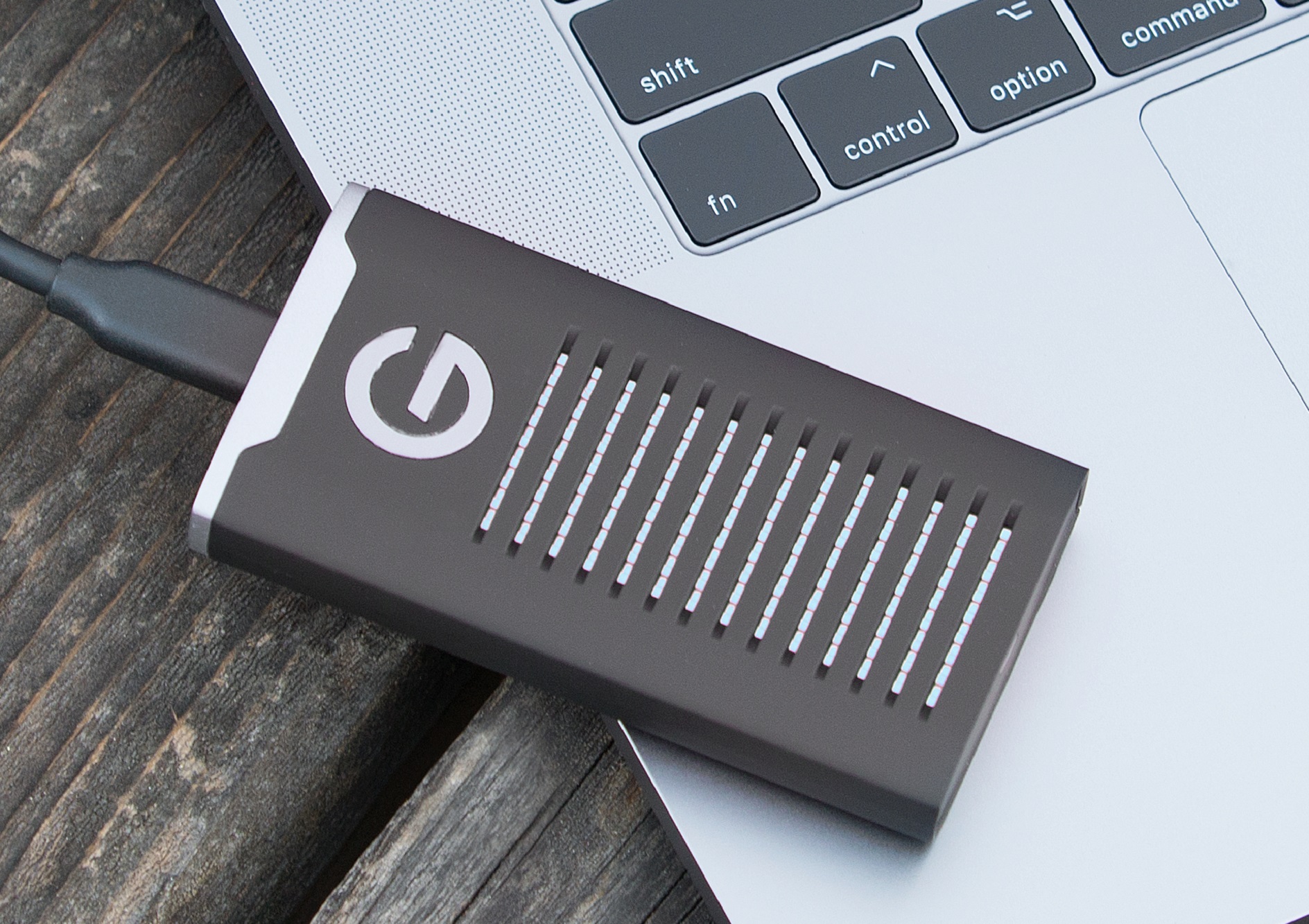
We're a picayune torn between recommending a Thunderbolt-based bulldoze for external storage versus a USB external bulldoze. While a Thunderbolt iii external SSD typically provides higher performance, that doesn't help you if your laptop doesn't have a Thunderbolt port, and many of those drives don't have any USB support. That makes SanDisk's G-Drive SSD the preferred drive. It doesn't support the more advanced, and also rare, USB SuperSpeed 20Gbps speeds, but it'south in the pinnacle tier with USB 10Gbps speeds, which is what you lot'll more often than not find. Perhaps more importantly for a photographer moving files in the field, is its tough shell. The drive is congenital with IP67 water-resistance and dust-resistance ratings and can withstand 2,000 pounds of weight, so you won't lose that precious photo of a ghost true cat in the mountains of Afganistan.
3. SanDisk Farthermost Pro Portable SSD – All-time performance USB drive


This is the one: SanDisk'due south Extreme Pro Portable SSD (1TB) is the fastest USB 3.one Gen 2 (10Gbps) external SSD we've tested to engagement. Burst performance is roughly on par with the runner-up Samsung T7, but it blows its competitor out of the water during long writes.
SanDisk's drive lacks the T7's handy (and fun) fingerprint security, only it's virtually the aforementioned toll and offers software-based password protection if security is a concern.
Notation: There are faster USB 3.2 ii×2 (also known as SuperSpeed 20Gbps) SSDs available, such as the WD Blackness P50 and Seagate Barracuda Fast SSD. However, SuperSpeed 20Gbps and USB4 ports are still so rare, we're non sure information technology matters. Those drives are also merely non as svelte equally the Farthermost Pro.
Read our full SanDisk Farthermost Pro Portable SSD review
4. Samsung Portable SSD T7 Touch (500GB) – Best operation runner-up
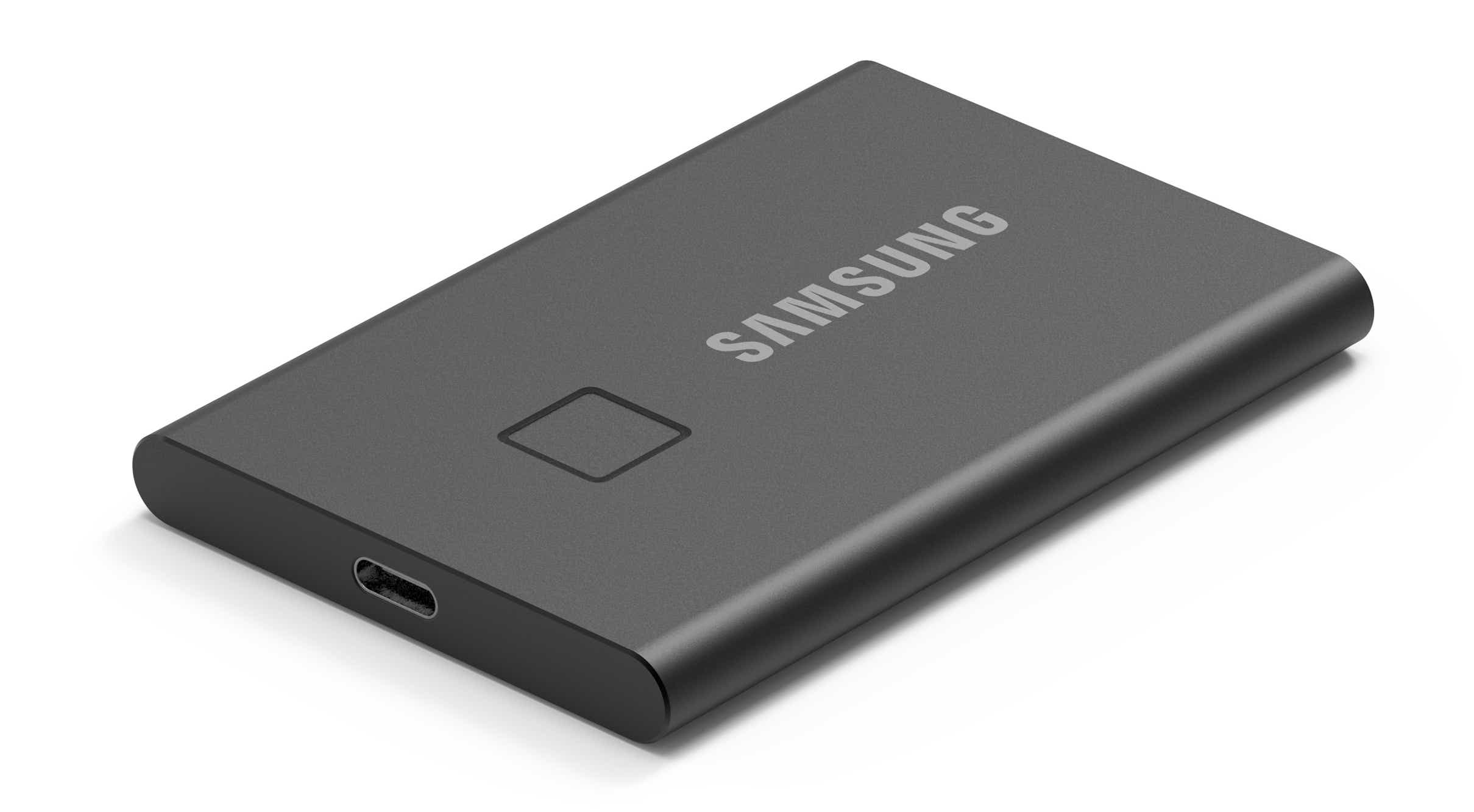

Samsung's Portable SSD T7 Affect runs a shut 2d to the SanDisk Extreme Pro Portable. Compared to its predecessor the T5, it's thinner, a significantly faster reader, and it also sports a fingerprint scanner.
Certain, yous could get a FIPS-certified secure drive (some businesses and government require it), just those cost far more than the T7, which provides some extra security while remaining within the price range of a normal USB SSD. That makes it a sweet deal for the boilerplate user who still wants effective data protection.
Read our total Samsung Portable SSD T7 Impact (500GB) review
5. Crucial X6 Portable SSD (2TB) – All-time budget selection
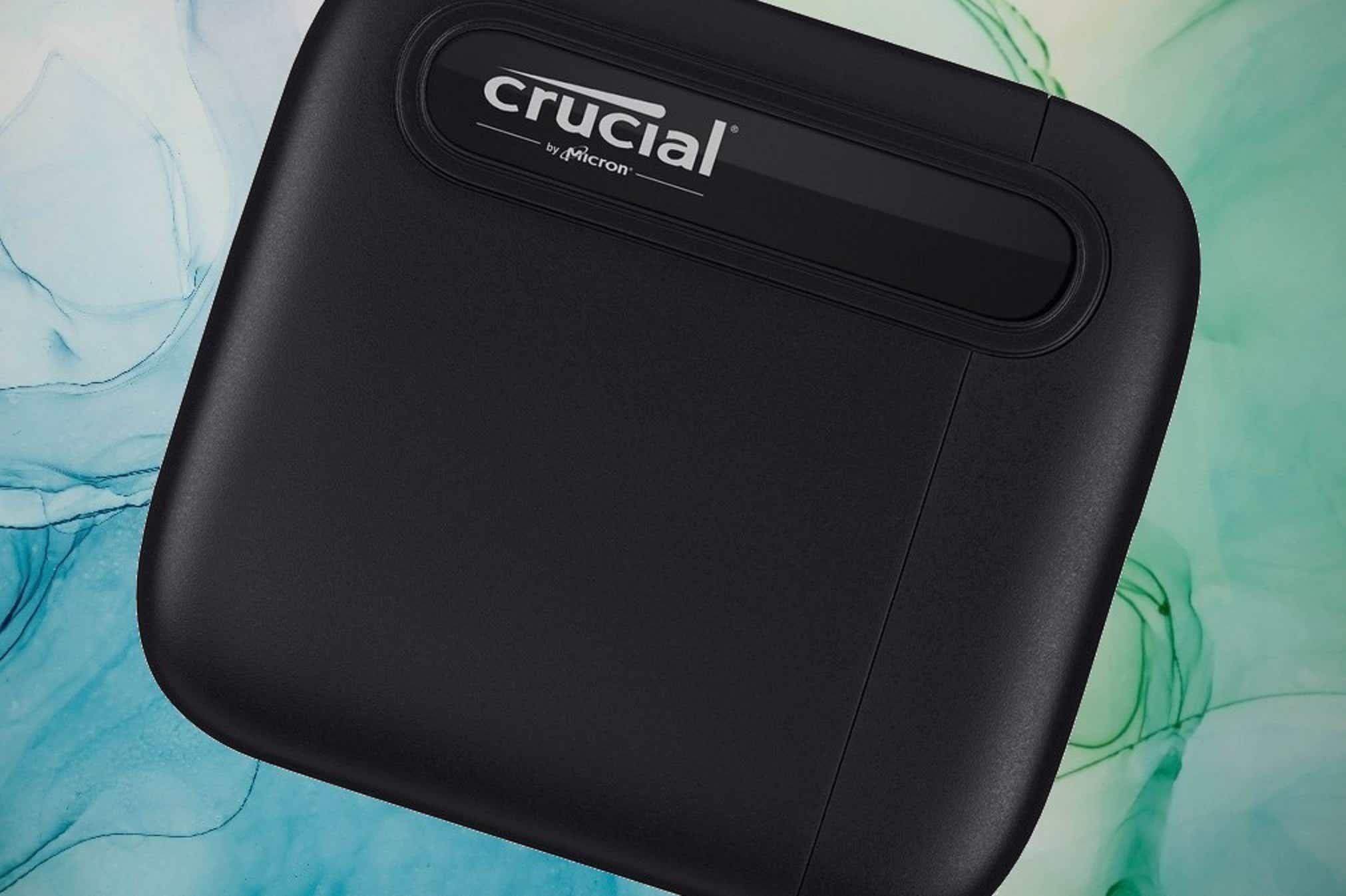

The Crucial X6 Portable SSD is square to exist hip. Or placed in your hip pocket, at any rate. In a sea of portable SSDs whose shape makes them a literal pain when pocketed, the thin, rounded-edge X6 is a sigh of relief. It's not country-of-the-art fast, but it's fast enough for most users and extremely affordable.
Read our full Crucial X6 Portable SSD (2TB) review
six. WD My Passport 5TB – All-time for backups

You want to know why we chose WD's My Passport 5TB for backups? It'south right there in the name—that extra 1TB can be invaluable in the age of 4K.
Read our full WD My Passport 5TB review
vii. Seagate Backup Plus Portable – Best for backups runner-up

Like the WD above, Seagate'due south Backup Plus Portable is a USB 3.1 Gen 1 (5Gbps) drive—plenty enough bandwidth for the hard drive inside. Chapters tops out at 5TB, but the bulldoze is also available in 1TB, 2TB, and 4TB sizes.
In our tests of the 4TB version, we found the Seagate to be slightly faster than the WD with large file transfers (think movies), merely slower with small file transfers (recollect Office documents). All in all, a worthy runner-up.
Read our full Seagate Backup Plus Portable review
8. Portable SSD X5 – All-time Thunderbolt three bulldoze
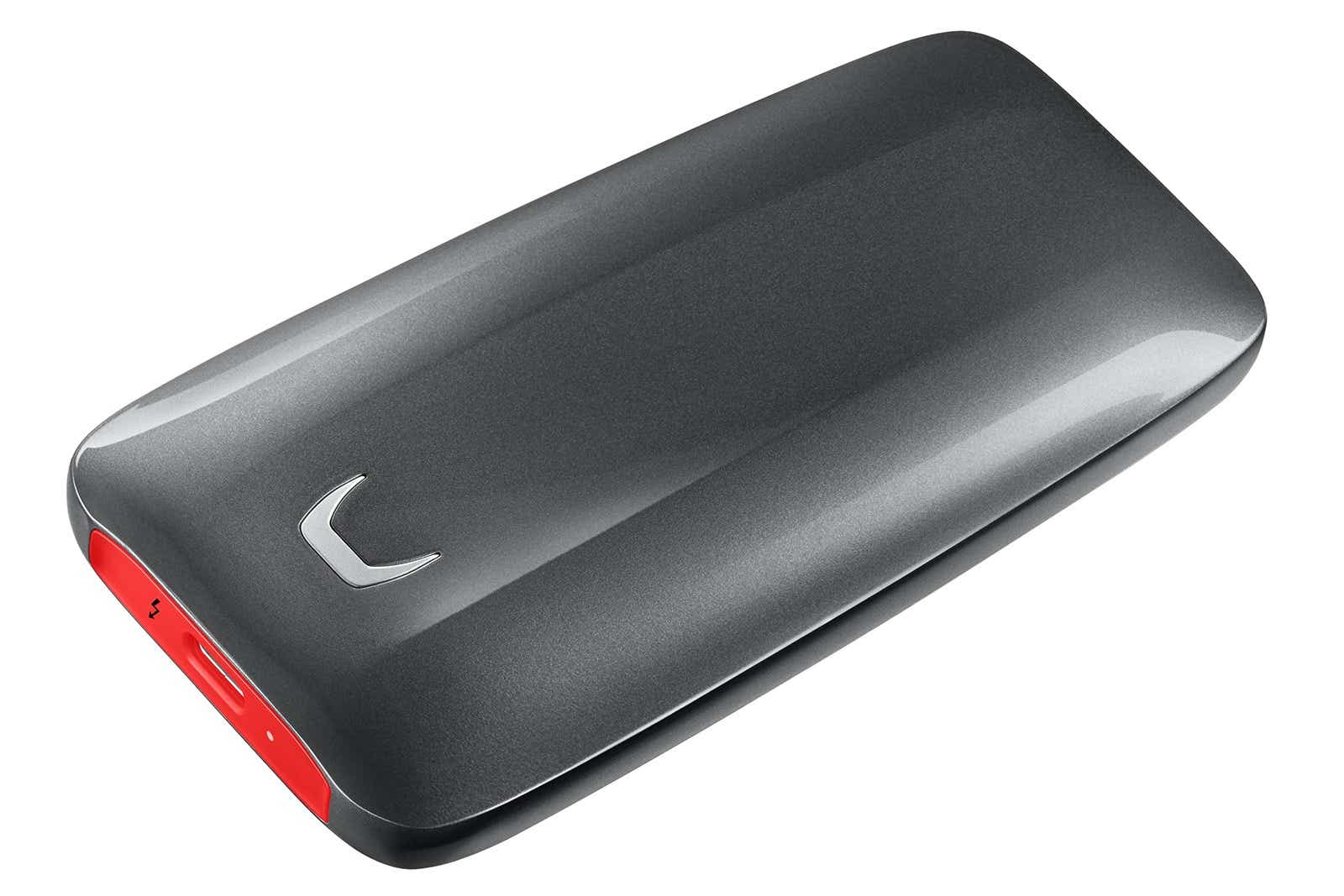
If you take Thunderbolt 3 or 4 on your system, you owe information technology to yourself to bank check out a portable Thunderbolt three drive such as Samsung'due south SSD X5. As an NVMe SSD using PCIe over a cable (that's basically what Thunderbolt 3 is), it'southward stupidly fast—over 2.5GBps reading and writing.
The merely reason we don't universally recommend the Portable SSD X5 is the relative rarity of Thunderbolt 3/four ports on PCs. The advent of USB4 should convalesce this, simply merely if vendors determine to combine it with the superset technology that is Thunderbolt 4. Or you may just soon encounter USB4 drives with the same 40Gbps transfer rates. Information technology gets complicated.
What yous need to know before you lot purchase
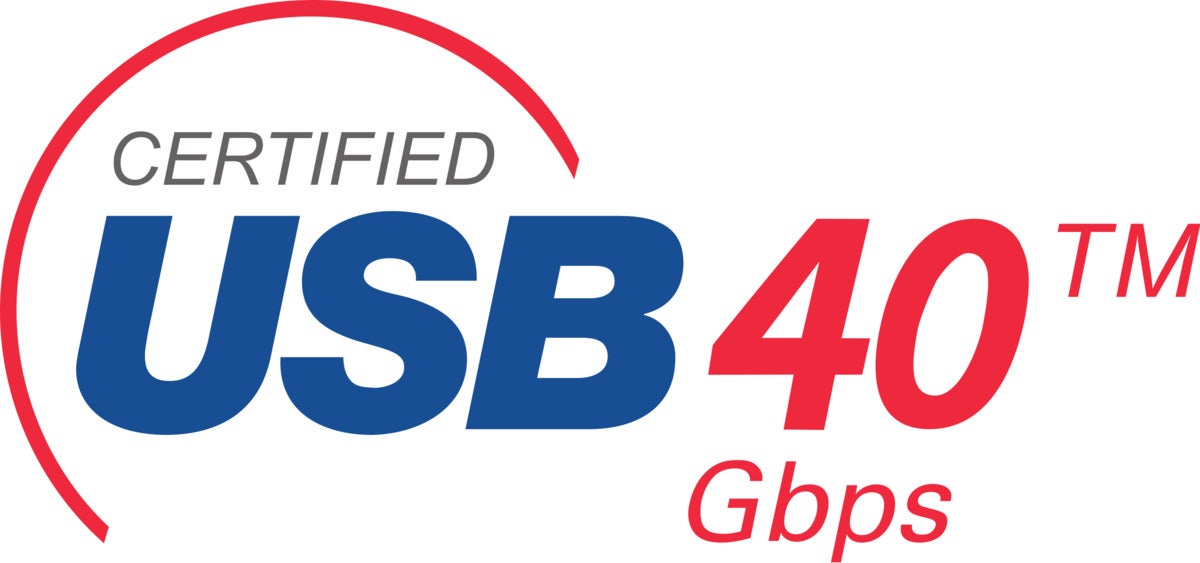
Yeah, USB4 volition provide the same massive throughput equally Thunderbolt 3 at lower prices eventually, and likely far more products too.
Capacity and toll
For most consumers, the main shopping concerns for external storage are capacity and price. However, while you lot might think that the everyman-toll drive provides the most value, it ofttimes doesn't. In fact, dollar for dollar, cheaper low-capacity drives are most often the worst bargain historically. We've been doing this comparison for years and it'south ever been the worst value.
You can see that below where we compare the popular WD Elements desktop difficult drive'southward available capacities and prices. You lot're paying more than twice as much for the lowest-chapters bulldoze versus the next step upwards. It'south almost equally as bad on the WD Elements Portable drive.
How much capacity do yous need?
The best "value" are typically for the largest hard drives as you can see, but it brings considerably higher prices and not anybody needs that much capacity. So how much practise you need? We recommend a backup drive at least twice as large equally the total chapters of your PC. If you have 1TB of storage in your PC, 2TB will allow you to brand a full backup while keeping historical backups on the same drive. Having more storage allows y'all to go on more than historical files should you need them or use the same drive to backup boosted PCs.
While the desktop drive provides a far higher chapters, they also crave more than cables, weigh more, and generally may not be quite every bit shock resistant equally a portable hard drive that'southward designed to take a few more bumps, even when on.

The worst value for an external hard drive is typically the lowest-capacity drive.
IDG
Interface
The vast bulk of external drives today are USB drives. Across that simple statement, the story gets confusing—largely because of the plethora of variations: USB 3.0, USB 3.1 Gen ane (5Gbps, which is basically USB 3.0), USB 3.two Gen 2 (10Gbps), and USB 3.2 Gen 2×2 (20Gbps), and now the up-and-coming USB4. In an attempt to simplify things, the USB Forum has recently inverse the nomenclature to bespeak throughput speed—SuperSpeed USB 5Gbps, SuperSpeed USB 10Gbps, and SuperSpeed USB 20Gbps—because performance is a priority for most uses. For the sake of brevity (and sanity), we generally shorten those names to USB 10Gbps, or 10Gbps USB, for instance.
No hard drive, unless combined in RAID with others, tin outstrip the 5Gbps (roughly 500MBps real-world after overhead) throughput of USB 3.i Gen ane. Don't worry about Gen 2, 10Gbps, or Thunderbolt with single hard drive enclosures because information technology doesn't really matter.
Where SuperSpeed 10Gbps/20Gbps, USB4, or Thunderbolt volition definitely help is with the aforementioned RAID hard drive setups, or more likely—an SSD. The good news is that while USB iii.ane Gen 2, which is more than fast enough for most users at 10Gbps, used to be expensive, it'due south basically the standard today. A SanDisk Farthermost Portable SSD, our runner-up for portable storage, can exist had for $90 in a 500GB capacity.
The faster USB 3.2 SuperSpeed 20Gbps (Gen two×2) moves you into a higher-price subclass, with the Seagate Firecuda Gaming SSD costing $200 for the same 500GB of storage. Although faster than the typical USB 3.2 SuperSpeed 10Gbps, at that place aren't a lot of USB 20Gbps gen 2×2 ports out there, but these drives should piece of work with the upcoming USB4 at the same 20Gbps footstep.
Thunderbolt iii and the newer Thunderbolt four typically are the highest-performing interfaces for external storage, with the central limitation being a premium price and a general lack of compatibility with the far more than pop USB three.2 ports in the world. Still, if you desire the nearly performance, you can get information technology in drives such as our recommended portable, the Samsung Portable SSD X5, which is $200 for 500GB of capacity. For comparison, a slower 1TB Samsung T5 on USB is just $125.
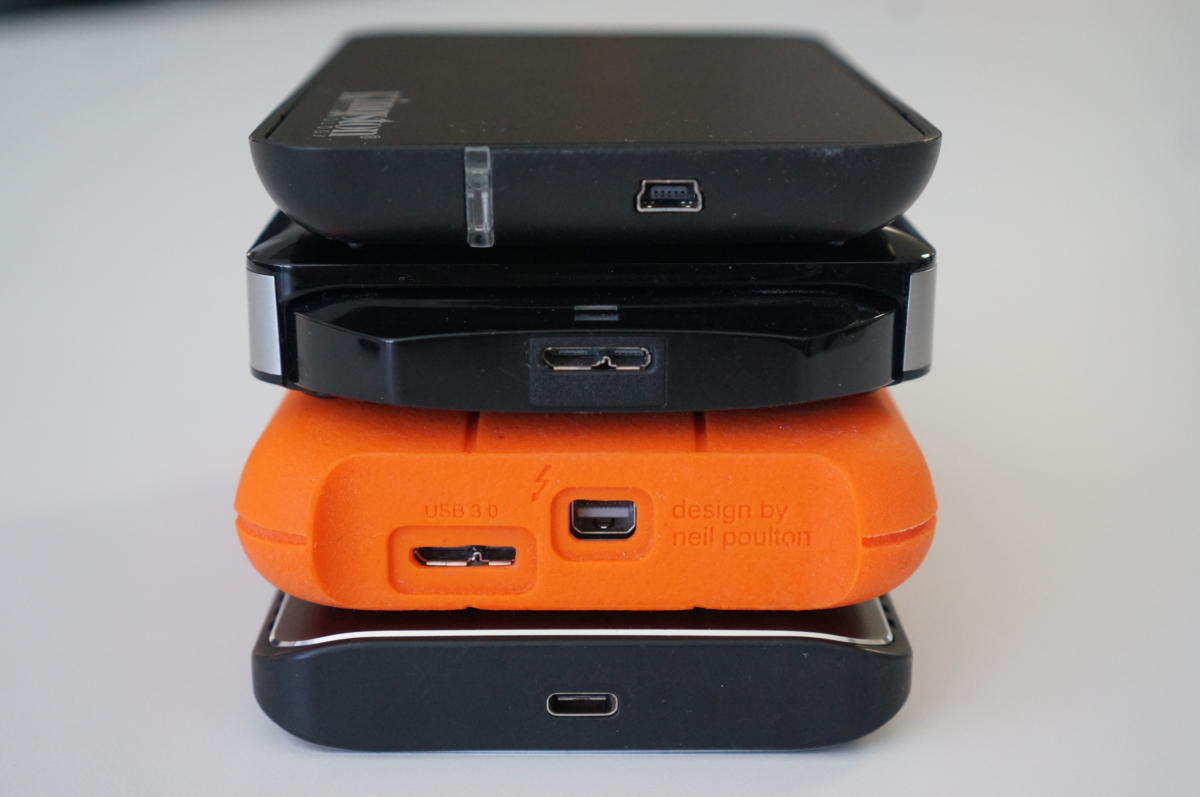
The summit drive uses the older, slower Mini-USB interface. The second drive features the connector that replaced information technology: Micro B SuperSpeed. The Orange bulldoze features both a SuperSpeed Micro B and Thunderbolt 2 (mini DisplayPort connector). The bottom drive features USB-C or USB Type C.
Ports
External drives come with a variety of ports, though they're gradually consolidating on the Type-C connector. Here's what yous need to care about:
USB iii Micro-BSuperspeed. This is still a very common port on many lower-cost portable and desktop external difficult drives today. It's actually the same Micro USB port used on your phone, just beefed upwards with more than data lines to hit USB 3.0 speeds. It'll do 5Gbps and is fine for hard drives and SATA (internally) SSDs.
USB 3 Type-B is the larger, blocky version of USB 3.0 Micro B. Type B ports are becoming rare, though y'all might find ane on enclosures supporting 5.25-inch hard drives or optical drives. It supports speeds upwards to 5Gbps.
USB-C is the latest of the USB connectors the earth is coalescing around. You meet information technology in everything from phones to laptops. Go on in mind, USB-C refers but to the connector itself. What is carried over the wires varies greatly. For example, for data transfers from an external drive, a USB-C port could mean everything from USB 2.0 High Speed (480Mbps) to USB three.2 SuperSpeed 20Gbps as well as USB4 and Thunderbolt 3. Any higher operation port today should be USB-C—just remember that just considering information technology's USB-C doesn't hateful the actual electronics inside the PC or bulldoze can hit the highest speeds of what a USB-C port can do.
USB Type-A You won't detect this port on any drive, but you will observe this familiar rectangular port on PCs and laptops. The reason we mention information technology is that any bulldoze with a Type-C port should come with a Type-C to Type-A cablevision or adapter, hopefully, since nigh PCs take those.
Thunderbolt 2 is at this point, a dead port. Using the mini-DisplayPort connector, it just really gained popularity on Macs, and even Apple put information technology out to pasture in 2017. There'due south no demand to invest in a Thunderbolt 2 bulldoze unless it's for legacy support issues.
Note that Apple makes a bi-directional Thunderbolt 1/2 to 3 adapter if you need to connect the ane to the other. It does not transfer ability, notwithstanding, so you can't employ information technology on its own with bus-powered external drives. You'll need a powered dock for that.
eSATA is some other legacy port that's basically disappeared. Created for attaching external storage to your computer's SATA bus, eSATA was a cheap way in its day to get beyond the 60MBps performance of USB 2.0. USB iii.0 put the last nail in its coffin. As with Thunderbolt two, the only reason to invest in an eSATA bulldoze is for use with older computers.
A 2d drive every bit backup?
In backup, in that location's a primal maxim accordingly named the Rule of 3. Information technology states that you should ever maintain three copies of your irreplaceable data: the original information, a backup, and a backup of the backup. Preferably, the two backups are kept in split up locations, ane being offsite. Keeping a copy online is great for smaller amounts of data and certainly meets the offsite criteria. Yet, for vast photograph, audio, and/or video collections, external drives in pairs (or more), are a faster, more practical solution.
Create complete backups alternately to the ii drives every few months. Truthful patrons of wisdom might fifty-fifty have the 2nd drive to work, so there'southward no chance of losing both drives to the same local disaster.
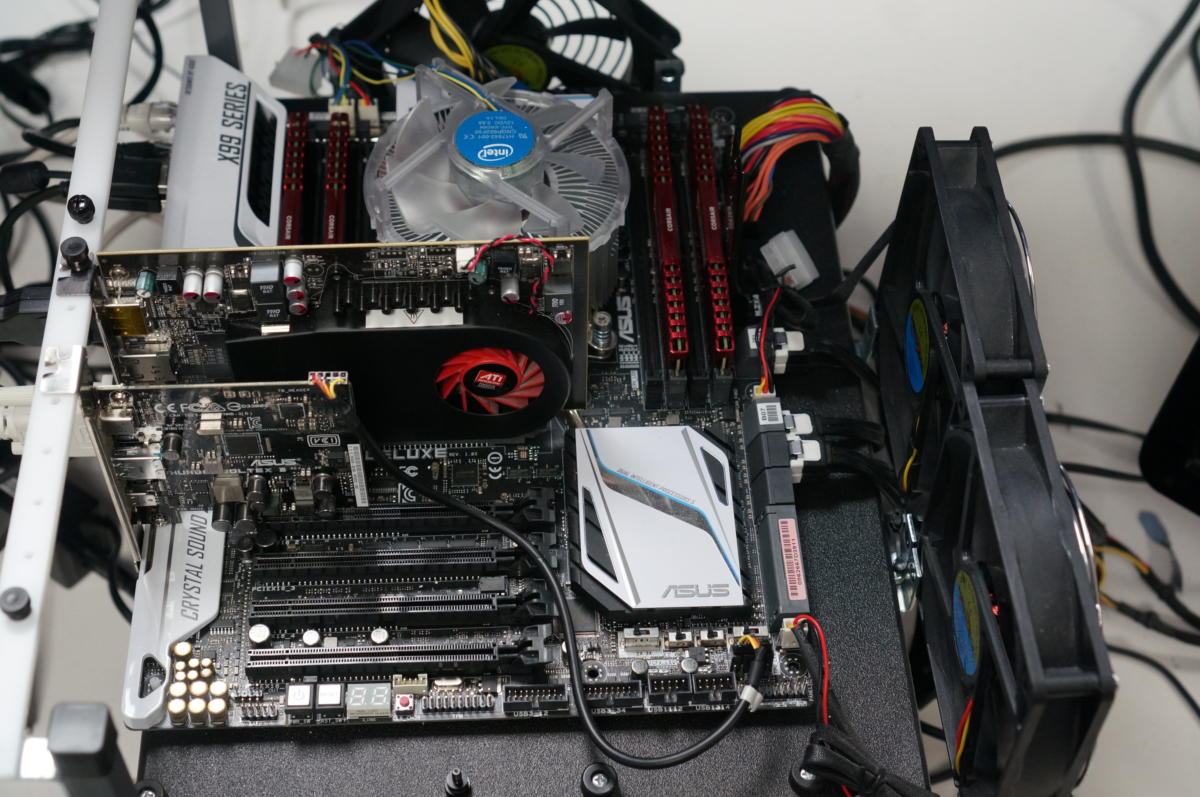
Our storage testbed is a Core i7-5820K with 64GB of RAM on an Asus X99 Deluxe lath. Older Asus Thunderbolt EX 3 and ATI graphics cards is shown. Currently a Gigabyte Alpine Ridge Thunderbolt card and x2 Nvidia 710 GPU card are employed.
How we tested
Nosotros use our standard storage test bed to evaluate the operation of every external drive we review. Information technology'due south a six-core (twelve-thread) Intel Core i7-5820K on an Asus X99 Deluxe motherboard with 64GB of Kingston DDR4 retentiveness running Windows 10.
A detached Gigabyte Alpine Ridge Thunderbolt 3 card and Ableconn USB three.two two×two 20Gbps card (Asmedia 2142 controller) are used for connecting the external drives. An Asus USB 3.one/10Gbps (Asmedia 1142 controller) card was employed for some of the older drives on the chart.
Nosotros run various synthetic benchmarks including Crystal Disk Mark 6/7/8, AS SSD 2, and Iometer. We also perform real-world transfer tests using a 48GB batch of small files and folders, as well as a single 48GB and 450GB files. The testbed boots from a NVMe drive, but the real-world (Windows) file transfers are performed to and from a 58GB RAM disk.
Our external bulldoze reviews
If you'd similar to learn more about our top picks likewise as other options, yous tin find links below to all the external drives we've reviewed. We'll continue evaluating new ones equally they get available, and then be certain to check back to see what other drives we've put through their paces.
Note: When you purchase something after clicking links in our articles, we may earn a small commission. Read our affiliate link policy for more details.
Source: https://www.pcworld.com/article/406861/best-external-drives.html
0 Response to "Samsung Portable Hard Drive Can T Read"
Post a Comment